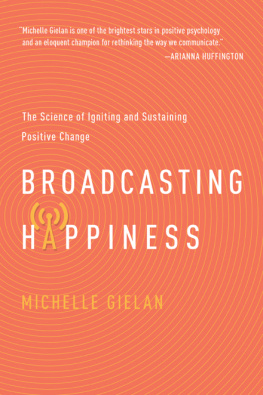CONTENTS

ABOUT THE BOOK
Raise your own game by building a great team
Forget everything you thought you knew about being your best. Its not about your own skills or talents real success comes from getting the most from the teams you build and the friends you make. You dramatically amplify your own potential by helping others realise theirs.
Shawn Achor is a Ted talk star and one of the worlds leading experts on happiness and success. In this book he provides a game-changing guide to greatness and outlines five simple steps you need to take. Packed with powerful stories, cutting-edge research and exclusive insights from Fortune 100 leaders, this book unlocks the secret of working with others to help you reach your Big Potential.
ABOUT THE AUTHOR
Shawn Achor is one of the worlds leading experts on the connection between happiness, success and potential. His research on mindset made the cover of Harvard Business Review, and his TED talk is one of the most popular of all time with 16 million views. He has worked with over a third of the Fortune 100 companies, the Pentagon and the White House, and lectured in more than 50 countries (from CEOs in China to doctors in Dubai and school children in South Africa). His Happiness Advantage training is one of the most successful corporate training programmes in the world. His research has been published in the New York Times, WSJ, Harvard Business Review, Forbes and Fortune. He is the author of The Happiness Advantage and Before Happiness.
ALSO BY SHAWN ACHOR
The Happiness Advantage
Before Happiness
The Ripples Effect
The Orange Frog
For Michelle and Leo, two brilliant lights of joy who daily remind me love is the only way to see our full potential
PART I

THE BIG PROBLEM WITH SMALL POTENTIAL
CHAPTER 1
THE POWER OF HIDDEN CONNECTIONS
The creation of a thousand forests is in one acorn.
RALPH WALDO EMERSON
THE MIRACLE OF THE MANGROVES
When dusk slowly crept upon a mangrove forest lining a river deep in a jungle in Southeast Asia, a biologist far from his home in Washington State looked out over the lush, alien landscape lining the snake-infested waters. While drifting slowly in his boat, Professor Hugh Smith surely heard the calls of the nocturnal creatures uncoiling from their dens or taking flight from their nests and beginning their nightly hunts. I can envision how the water must have shimmered under the light from the stars, unspoiled by the light pollution that existed in the remote cities. What happened next on that humid day in 1935 is part of recorded academic history. Smith looked up at one of the mangrove trees, and suddenly the entire canopy glowed as if a lightning bolt had shot out from the tree instead of striking it. Then all went dark, leaving a burned image on his vision.
Then lightning, as it sometimes does, struck twice.
The entire tree glowed again, then went entirely dark again twice in three seconds. Then, in a reality-bending moment, all of the trees along the riverbank suddenly glowed in unison. Every tree on one side of the river for a thousand feet was flashing and going dark at exactly the same time.
Something deep inside me warms at the thought that such a patient, careful, and scientific observer, whose curiosity about the world led him so far away from his normal life in the Pacific Northwest, could be rewarded that night by such a magical moment of nature.
Once his capacity for mental reasoning returned, he realized that the trees were not, in fact, glowing; rather, they were covered with a critical number of bioluminescent lightning bugs, all illuminating at the exact same time. Upon returning home, Dr. Smith wrote up a journal article on his discovery of the synchronous lightning bugs. It seemed too good to be true, like something out of a storybook. Im sadly unsurprised by the next part of the story. He was not believed. Biologists ridiculed his account, even calling it fabricated. Why would male fireflies glow in unison, which would only decrease their chances of distinguishing themselves to potential mates? Mathematicians were equally skeptical. How could order come from chaos in nature without a leader to direct it? And entomologists asked how millions of fireflies could see enough other fireflies to create the exact same pattern, given the limited visibility in the mangrove forest. It seemed physically, mathematically, and biologically impossible.
Yet, it wasnt. And now, thanks to modern science, we know how and why. Turns out that this puzzling behavior actually serves an evolutionary purpose for the fireflies. As published in the prestigious journal Science, researchers Moiseff and Copeland found that when lightning bugs light up at random times, the likelihood of a female responding to a male in the deep, dark recesses of a mangrove forest is 3 percent. But when the lightning bugs light up together, the likelihood of females responding is 82 percent. Thats not a typo. The success rate increased by 79 percentage points when flashing as an interconnected community rather than as individuals.
Society teaches that its better to be the only bright light than be in a forest of bright lights. After all, isnt that the way we think about success in our schools and companies? We want to graduate at the top of our class, get the job at the best company, and be chosen to work on the most coveted project. We want our child to be the smartest kid at school, the most popular kid on the block, the fastest kid on the team. When any resourcebe it acceptance to the most prestigious university, an interview with a top-ranking company, or a spot on the best athletic teamis limited, we are taught that we have to compete in order to differentiate ourselves from the rest of the pack.
And yet, my research shows that this isnt actually the case. The lightning bug researchers discovered that when the fireflies were able to time their pulses with one another with astonishing accuracy (to the millisecond!), it allowed them to space themselves apart perfectly, thus eliminating the need to compete. In the same way, when we help others become better, we can actually increase the available opportunities, instead of vying for them. Like the lightning bugs, once we learn to coordinate and collaborate with those around us, we all begin to shine brighter, both individually and as an ecosystem.
But pause to think for a moment. How did lightning bugs even do it? How did they all coordinate their flashing lights so perfectly , especially given their limited visibility and vision? Researchers Mirollo and Strogatz from Boston College and MIT found in the Journal of Applied Mathematics that, amazingly, the fireflies do not have to see everybody to create coordinated action; so long as no group of fireflies is completely out of sight of any other group, they can sync up with one anothers rhythms.











